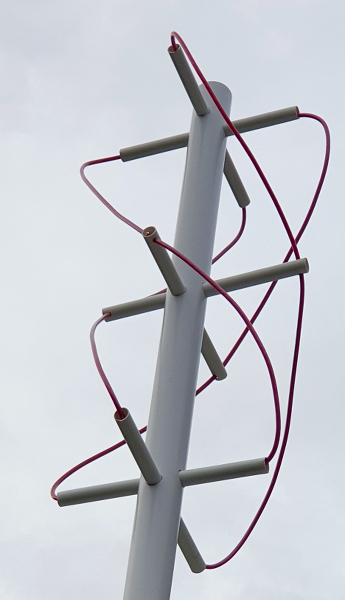Project in Progress ....... -.-. --.- -.-. --.-
Receiving the NOAA Weather Satellites is a fairly easy project to complete, and with the use of an SDR, Cheap or moderately expensive the pictures can be received and saved away, displayed on a website or just to take a quick look at.
The main components needed will be no surprise ;
- Antenna - A QFH or Quadrifilar Helix Antenna made from a Coax off-cut
- Low Noise Amplifier and accessories - NooElec Sawbird + NOAA, 5v Bias Tee and DC Blocker.
- Receiver - ADALM Pluto SDR
Quadrafilar Helix Antenna
The antenna was built using a number of instruction pages on the internet as none of them actually demonstrated the Coax QFH right through to the end. Some of my measurements were abitrary and also due to a materials supply issue (Screwfix sold me a 55mm Pipe and not a 50mm as ordered and I didn't notice till I'd cut it up.) I had to deviate somewhat.
General Construction
The principals are for a QFH to receive APT Weather pictures you need a RHCP (Right Hand, Circular Polarised) antenna. Yes, an Omni Vertical will pick up the signal somewhat, but not at a level where you can raster the images. This does look time consuming or difficult but it's not when you get started. In the case of the antenna I built, it took an afternoon.
Mine is built to this specification, partially - https://www.instructables.com/NOAA-Satellite-Signals-with-a-PVC-QFH-Antenna-and-
The key aspects of this is to measure the hole placement, then measure them again. Then measure them again. What I found was when using the http://jcoppens.com/ant/qfh/calc.en.php calculator, the above design needs some adjustment. Remember, you are using a Coax QFH, not a Copper one so some measurements change. Anyway, the wiring diagram is correct and therefore it is performant. I did sweep it with my antenna analyser, which confirmed it was a near match. As we're not transmitting, this isn't needed.

Coax QFH Antenna (22mm Conduit into 55mm PVC Waste pipe)
Low Noise Amplifier
Installation of the will assist in picking up the low horizon signals, and with the SAW filter in this particular device, helps with string adjacent signals from other sources like FM Broadcast which is near by. The device chosen here is the NooElec Sawbird + NOAA which is a Bias Tee powered filtered Pre-Amplifier which can be mast head mounted. I wanted to mount this inside the antenna, but could not easily connect it so have placed inside a mast mounted box. The Coax I used was also too big for an SMA fitting, so is terminated in BNC, then converted to SMA inside to the Pre-Amp.
The Bias T and 5v Supply are Generic Ebay Items. The Pluto also requires a DC Block on the input. It will go into protection mode without it.
Receiver
The ADALM Pluto SDR is more expensive than your RTL dongles, about £100 more but you do get transmit capability and opensource firmware, Access to a FPGA and embedded linux for projects too. The down side for experimentation, its an expensive device when you stick too much DC in the front end and kill the device. Luckily it has some good protection circuits, which have been well tested by me with various school boy errors (My defence is that I only have a degree in SatComms and that was 25 years ago, and I didn't kill the HP Spectrum Analyser in the lab with DC back then either)
Using SDR Console, this software enables complete control of the receiver and what we need to do for receiving a signal. There are others, like SDR# and SDR Angel but I've used HRD Deluxe for years, which Simon originally wrote (Fact: I still use his last version, because I like it better than the recent releases)
Virtual Patch Cable - This takes the Audio out from the SDR and allows it to be piped back into another application, which is WXtoIMG...
WXtoIMG Reloaded - This software does the heavy lifting, where it can show the schedules of the passes and receives, renders and organises the images. It also places them into a webpage for external viewing.
Capturing other things
Building all this kit, and a dedicated machine to capture these images is fine, but what else can it do ? well, the other part of SDR Console which deals with Satellites will allow all manner of capabilites that are really useful like sorting Doppler Shift and tracking passes but it also allows scheduling and controlling the SDR. This means the operation of moving between the 3 NOAA satellites is automated. It also means other satellites that are passing, like the ISS can also be received. Now, whilst the ISS does not transmit with RHCP, it instead uses a vertically polarised antenna, the losses are not so much that any of the SSTV pictures which are occasionally transmitted are not able to be captured.
